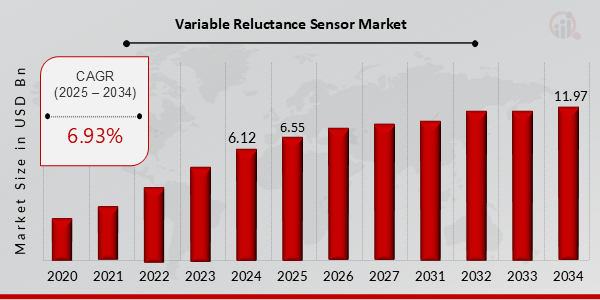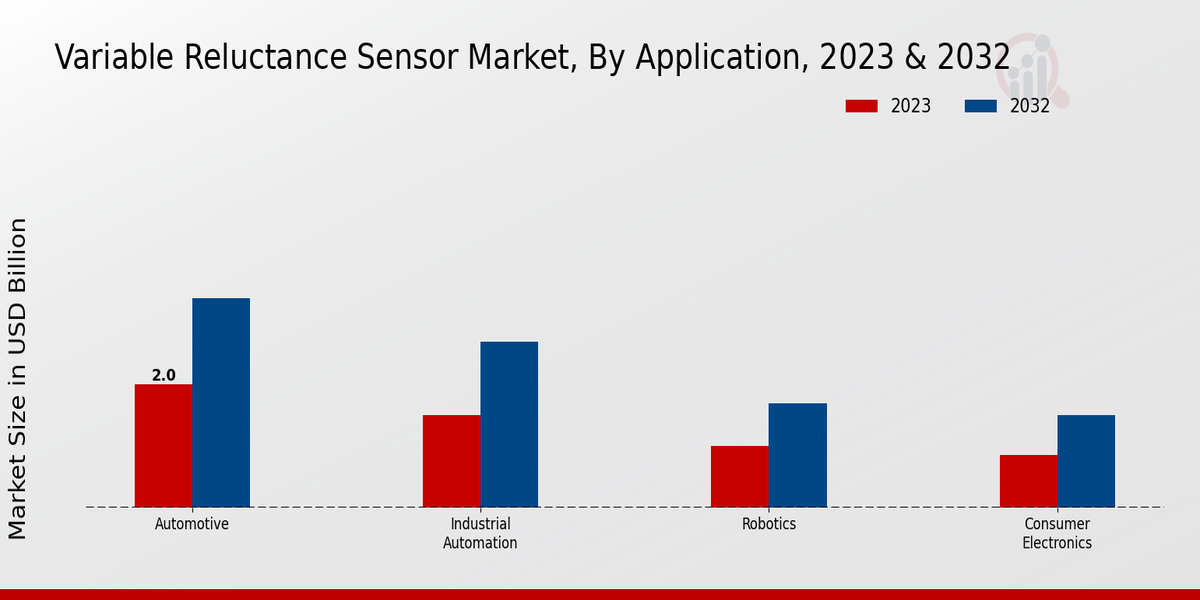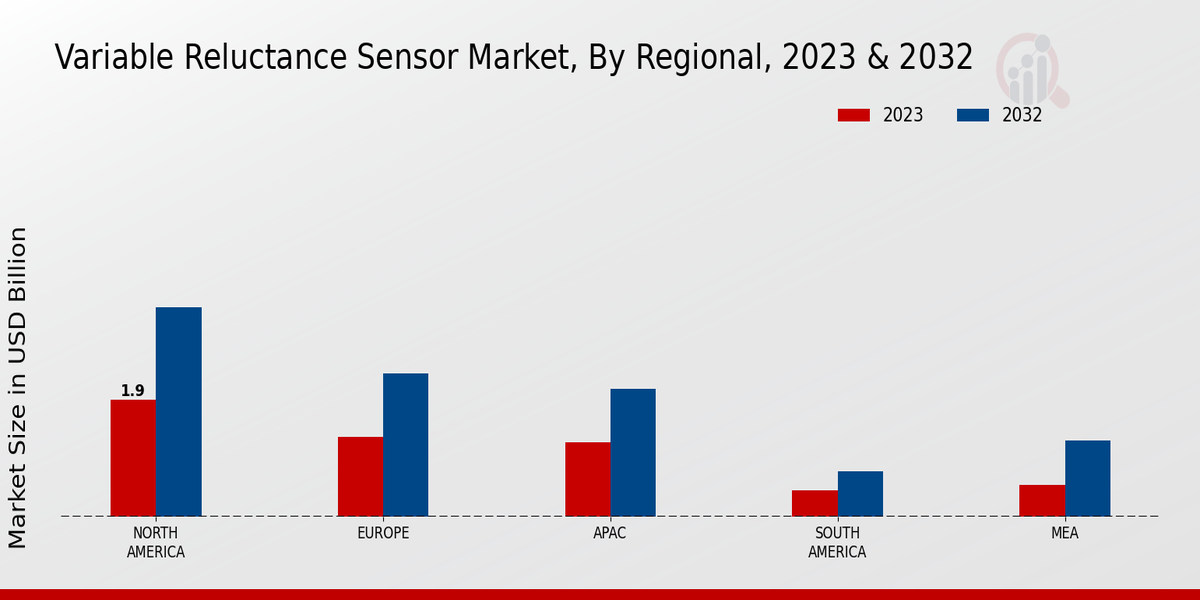Global Variable Reluctance Sensor Market Overview
Variable Reluctance Sensor Market Size was estimated at 6.12 (USD Billion) in 2024. The Variable Reluctance Sensor Market Industry is expected to grow from 6.55 (USD Billion) in 2025 to 11.97 (USD Billion) till 2034, exhibiting a compound annual growth rate (CAGR) of 6.93% during the forecast period (2025 - 2034).
Key Variable Reluctance Sensor Market Trends Highlighted
The Variable Reluctance Sensor Market is witnessing significant growth driven by increasing demand for advanced sensing technologies across various industries. Key market drivers include the rising adoption of automation in sectors like manufacturing and automotive, where precision and reliability are paramount.
Moreover, the integration of Internet of Things (IoT) technology is enhancing the functionality of variable reluctance sensors, making them essential for real-time monitoring and data collection.
As industries strive for improved efficiency and reduced operational costs, the need for high-performance sensors continues to rise. Opportunities in the market are expanding as more sectors recognize the advantages of employing variable reluctance sensors.
The automotive industry is particularly poised to benefit from the shift towards electric vehicles that require sophisticated sensor systems for performance optimization. Additionally, emerging applications in robotics and industrial automation present avenues for growth, allowing manufacturers to innovate and diversify their product offerings.
This creates potential for companies to capture new markets by enhancing their sensor technology. In recent times, the market has also seen trends focusing on sustainability and energy efficiency. The development of sensors designed for low-power applications aligns with global sustainability goals, appealing to environmentally conscious consumers and businesses.
Furthermore, advancements in materials and manufacturing processes are contributing to lightweight, compact sensor designs, making them more versatile. As industries evolve and new technologies emerge, the demand for variable reluctance sensors will likely continue to grow, paving the way for enhanced capabilities and applications across various fields.

Source: Primary Research, Secondary Research, MRFR Database and Analyst Review
Variable Reluctance Sensor Market Drivers
Increasing Demand for Advanced Sensing Technologies
The Variable Reluctance Sensor Market is experiencing significant growth driven by the increasing demand for advanced sensing technologies across various applications. As industries strive for greater efficiency, precision, and reliability in their operations, the need for sophisticated sensors that can provide accurate and real-time data has surged.
Variable reluctance sensors, known for their ability to measure angular position and speed, are being incorporated into various applications such as automotive, aerospace, robotics, and industrial automation.
These sensors offer several advantages, including high sensitivity, robustness, and the ability to function effectively in harsh environments. The growing trend towards automation and smart technologies is further augmenting the demand for reliable sensing solutions.
Businesses are recognizing the crucial role that variable reluctance sensors play in optimizing processes, enhancing safety, and improving overall performance. As a result, investments in research and development for innovative sensing technologies are on the rise, fueling the growth trajectory of the Variable Reluctance Sensor Market.
Moreover, as industries increasingly adopt Internet of Things (IoT) solutions, the integration of variable reluctance sensors into smart devices is becoming commonplace, highlighting their importance in modern applications. This overall surge in technological advancement is creating a robust market landscape, propelling the future prospects of the Variable Reluctance Sensor Market.
Growth of Automotive Industry
The robust expansion of the automotive industry is significantly influencing the growth of the Variable Reluctance Sensor Market. With the increasing demand for advanced safety and efficiency in vehicles, manufacturers are incorporating variable reluctance sensors into various systems, including anti-lock braking systems, electronic stability control, and engine management.
These sensors play a crucial role in enhancing vehicle performance and ensuring safety, which is becoming increasingly important to consumers.
Rising Focus on Industrial Automation
The growing emphasis on industrial automation is another key driver for the Variable Reluctance Sensor Market. As manufacturers seek to optimize production processes, variable reluctance sensors are being integrated into automated machinery for monitoring and control purposes. This trend leads to increased efficiency and productivity, driving the demand for these sensors across various sectors.
Variable Reluctance Sensor Market Segment Insights:
Variable Reluctance Sensor Market Application Insights
The Variable Reluctance Sensor Market revenue is projected to experience substantial growth, particularly in its application segment, which encompasses critical fields like Automotive, Industrial Automation, Robotics, and Consumer Electronics.
Within this segment, the Automotive sector particularly dominated the market, registering a valuation of 2.0 USD billion in 2023 and expected to reach 3.4 USD billion in 2032. This superiority reflected the increasing adoption of advanced sensing technologies in vehicles, enhancing safety and performance.
Similarly, Industrial Automation also played a pivotal role in the Variable Reluctance Sensor Market statistics, with a valuation of 1.5 USD billion in 2023 that is set to grow to 2.7 USD billion by 2032. This growth is driven by the ongoing trend towards automation in various industries, as companies increasingly seek to improve efficiency and reduce human error.
Robotics, with a current valuation of 1.0 USD billion set to expand to 1.7 USD billion, showcased its significance as well, given the rise in automation and reliance on robots for precision tasks. The application of variable reluctance sensors in this area is paramount, as they offer enhanced accuracy and reliability.
In contrast, the Consumer Electronics segment accounted for a smaller share of the Variable Reluctance Sensor Market revenue, starting at 0.86 USD billion in 2023 and projected to reach 1.5 USD billion in 2032.
While this segment shows promise, it is less dominant compared to the aforementioned sectors. This discrepancy highlights the varied demand across different applications, with Automotive and Industrial Automation leading the charge due to their substantial requirement for advanced sensor technologies.
This segmentation insight illustrates not only the current market landscape but also the trajectories and growth opportunities within the Variable Reluctance Sensor Market, reflecting the various trends and drivers that influence market growth in each domain.
The increase in the reliance on smart technology and automation presents numerous opportunities for development within these applications, positioning them favorably in the market landscape.

Source: Primary Research, Secondary Research, MRFR Database and Analyst Review
Variable Reluctance Sensor Market Technology Insights
The overall landscape of this market includes various essential technologies like Magnetic Sensors, Proximity Sensors, Position Sensors, and Speed Sensors, each playing a vital role in diverse applications. Magnetic Sensors, for instance, dominate the market due to their reliability in detecting the strength and direction of magnetic fields, which is essential in automotive and industrial sectors.
Proximity Sensors offer substantial utility by providing contactless detection, which further enhances the growth of smart devices and automation technologies. Position Sensors are crucial in robotics and automation, enabling precise control and positioning, while Speed Sensors are integral to performance monitoring in various machinery.
The interplay of these technologies underlines the market's resilience and adaptability, driven by increasing demand for automation, IoT integration, and the push for advanced manufacturing techniques. Overall, the Variable Reluctance Sensor Market data reflects a positive trajectory, showcasing robust trends and underlying growth drivers integral to addressing emerging industrial challenges.
Variable Reluctance Sensor Market End Use Insights
The Variable Reluctance Sensor Market is projected to see significant growth across various end use sectors, contributing to its overall revenue growth.
The transportation sector plays a crucial role, utilizing these sensors for vehicle position and speed detection, enhancing safety and efficiency in modern transportation systems. The manufacturing industry also crucially relies on variable reluctance sensors for automation and process control, ensuring precision in production lines.
In telecommunication, these sensors are vital for monitoring signals and improving network reliability, reflecting the increasing demand for data and communication technology. The healthcare industry utilizes variable reluctance sensors for patient monitoring and medical device applications, making significant contributions to patient care advancements.
The diverse applications across these sectors highlight the importance of variable reluctance sensors in driving innovation and enhancing operational efficiency, thus underscoring their relevance in the ongoing market growth and development.
Overall, the Variable Reluctance Sensor Market data illustrates the intersections of technology and industrial applications, presenting numerous opportunities and insights for stakeholders.
Variable Reluctance Sensor Market Sensor Type Insights
The Variable Reluctance Sensor Market encompasses various sensor types that cater to diverse applications across industries. Among these, Single Axis Sensors hold a significant portion of the market due to their utility in applications requiring precise measurement in one direction, often in the automotive and robotics sectors.
Multi-Axis Sensors are also gaining traction, thanks to their capability of measuring movements across multiple dimensions, making them ideal for complex motion tracking in various fields like aerospace and gaming technology.
Digital Sensors are becoming increasingly important as they provide real-time data processing and enhanced accuracy, which is essential for modern automated systems and IoT devices. The combination of these technologies not only shows the versatility of the Variable Reluctance Sensor Market but also highlights a strong growth trajectory driven by the demand for advanced sensing solutions.
As industries continue to seek efficiency and precision, market growth is bolstered by the ongoing innovation and development within these sensor types, addressing both existing and emerging needs in the market.
Variable Reluctance Sensor Market Regional Insights
The Variable Reluctance Sensor Market is characterized by a diverse regional landscape, with significant valuations across various areas. In North America, the market was valued at 1.902 USD billion in 2023 and is expected to grow to 3.405 USD billion by 2032, showcasing its majority holding due to the region's advanced automotive and industrial applications.
Europe followed, having a market valuation of 1.297 USD billion in 2023, projected to reach 2.325 USD billion in 2032, reflecting a robust demand for innovative sensors in diverse sectors. The APAC region recorded a valuation of 1.21 USD billion in 2023 and is anticipated to achieve 2.076 USD billion by 2032, supported by rapid industrialization and growing electronics manufacturing.
South America held a valuation of 0.432 USD billion in 2023 and is set to grow to 0.747 USD billion, indicating emerging opportunities despite being a smaller market. Lastly, the MEA region, valued at 0.519 USD billion in 2023, is expected to rise to 1.246 USD billion in 2032, reflecting increasing investment in technology and automation.
This market segmentation highlights significant regional growth dynamics and the overall Variable Reluctance Sensor Market statistics, indicating strong opportunities for stakeholders in the coming years.

Source: Primary Research, Secondary Research, MRFR Database and Analyst Review
Variable Reluctance Sensor Market Key Players and Competitive Insights:
The Variable Reluctance Sensor Market is witnessing significant dynamics as it evolves with technological advancements and increasing demand across various sectors. Competitive insights in this market highlight the key players' strategies, innovations, and market positioning that shape industry trends.
With the rising applications of variable reluctance sensors in automotive, industrial automation, and consumer electronics, companies are focusing on enhancing performance, accuracy, and integration capabilities to maintain competitiveness.
The market landscape is characterized by a mix of established and emerging players who are optimizing their product portfolios and investing in research and development to cater to the varied needs of customers.
Strategic partnerships, mergers, and acquisitions are also prevalent as firms aim to leverage complementary strengths and gain a larger market share, thus intensifying the competition within the sector.
STMicroelectronics stands out as a robust player in the Variable Reluctance Sensor Market, providing a diverse range of innovative solutions tailored to enhance sensing performance. The company boasts significant expertise in the semiconductor field, enabling it to harness cutting-edge technology for developing high-quality sensors that meet industry standards.
Its strong focus on research and development has equipped STMicroelectronics with a solid foundation for ongoing product innovation, which is vital in a rapidly changing market. The company capitalizes on its extensive global presence and established relationships with key customers in the automotive and industrial sectors, thereby leveraging its strengths in delivering efficient and reliable sensor solutions.
With a commitment to sustainability and reduced power consumption, STMicroelectronics has positioned itself as a preferred choice for many enterprises seeking advanced variable reluctance sensors. Texas Instruments also plays a pivotal role in the Variable Reluctance Sensor Market, where its commitment to technology and innovation significantly bolsters its competitive standing.
The company is known for its strong portfolio of sensor products that integrate seamlessly into various applications, providing high accuracy and efficiency. Texas Instruments emphasizes robust platform designs and extensive support for engineers, thus facilitating easier implementation of variable reluctance sensors in diverse projects.
Its engineering expertise ensures that the products deliver high performance while also emphasizing cost-effectiveness, making them attractive options for potential clients. With sound distribution channels and a strong reputation for reliability, Texas Instruments continues to capture a notable share of the market while working on new advancements to address the industry's evolving demands.
Key Companies in the variable reluctance sensor market Include:
- STMicroelectronics
- Texas Instruments
- Honeywell
- Infineon Technologies
- TE Connectivity
- Broadcom
- Balluff
- Emerson Electric
- Analog Devices
- Bosch
- NXP Semiconductors
- Siemens
- Renesas Electronics
- Omron
- Microchip Technology
Variable Reluctance Sensor Market Developments
Recent developments in the Variable Reluctance Sensor Market have showcased significant growth and strategic movements among key players such as STMicroelectronics, Texas Instruments, and Honeywell. There is an increasing demand for these sensors driven by advancements in automotive applications, consumer electronics, and industrial automation.
Companies like Infineon Technologies and TE Connectivity are investing in research and development to enhance sensor precision and robustness, which is critical in electric vehicle technology. Additionally, Broadcom and Balluff are exploring collaborations to strengthen their market presence.
In terms of mergers and acquisitions, Emerson Electric's acquisition of a key technological firm has further solidified its position, aiming to leverage synergies in sensor technology. Simultaneously, Analog Devices and Siemens have recently expanded their portfolios through strategic partnerships, enhancing their capabilities in various applications.
The market dynamics are marked by rising valuations and an increasing focus on sustainability and efficiency in sensor design, significantly impacting future growth trajectories and technology innovations in the Variable Reluctance Sensor Market.
Variable Reluctance Sensor Market Segmentation Insights
-
Variable Reluctance Sensor Market Application Outlook
- Automotive
- Industrial Automation
- Robotics
- Consumer Electronics
-
Variable Reluctance Sensor Market Technology Outlook
- Magnetic Sensors
- Proximity Sensors
- Position Sensors
- Speed Sensors
-
Variable Reluctance Sensor Market End Use Outlook
- Transportation
- Manufacturing
- Telecommunication
- Healthcare
-
Variable Reluctance Sensor Market Sensor Type Outlook
- Single Axis Sensors
- Multi-Axis Sensors
- Digital Sensors
-
Variable Reluctance Sensor Market Regional Outlook
- North America
- Europe
- South America
- Asia Pacific
- Middle East and Africa
|
Report Attribute/Metric
|
Details
|
|
Market Size 2024
|
USD 6.12 Billion
|
|
Market Size 2025
|
USD 6.55 Billion
|
|
Market Size 2034
|
USD 11.97 Billion
|
|
Compound Annual Growth Rate (CAGR)
|
6.93% (2025-2034)
|
|
Base Year
|
2024
|
|
Market Forecast Period
|
2025-2034
|
|
Historical Data
|
2020-2023
|
| Market Forecast Units |
USD billion |
| Key Companies Profiled |
STMicroelectronics, Texas Instruments, Honeywell, Infineon Technologies, TE Connectivity, Broadcom, Balluff, Emerson Electric, Analog Devices, Bosch, NXP Semiconductors, Siemens, Renesas Electronics, Omron, Microchip Technology |
| Segments Covered |
Application, Technology, End Use, Sensor Type, Regional |
| Key Market Opportunities |
Increasing demand in the automotive sector, Growing adoption of industrial automation, Advancements in sensor technology, Rise in smart home applications, Expanding electric vehicle market |
| Key Market Dynamics |
Technological advancements, Growing automotive applications, Increasing demand for automation, Rising need for accurate measurements, Expansion in industrial IoT applications |
| Countries Covered |
North America, Europe, APAC, South America, MEA |
Frequently Asked Questions (FAQ) :
The Variable Reluctance Sensor Market is expected to be valued at 11.97 USD billion by 2034.
The expected CAGR for the Variable Reluctance Sensor Market from 2025 to 2034 is 6.93%.
North America is anticipated to hold the largest market share, valued at 3.405 USD billion by 2032.
The Automotive application segment of the Variable Reluctance Sensor Market is projected to reach 3.4 USD billion by 2032.
Major players include STMicroelectronics, Texas Instruments, Honeywell, Infineon Technologies, and TE Connectivity.
The Industrial Automation application segment is expected to be valued at 2.7 USD billion by 2032.
The Robotics application segment is expected to grow to 1.7 USD billion by 2032.
The Consumer Electronics application segment is expected to reach 1.5 USD billion by 2032.
The APAC region is projected to have a market value of 2.076 USD billion by 2032.
The Variable Reluctance Sensor Market was valued at 5.36 USD billion in 2023.

















